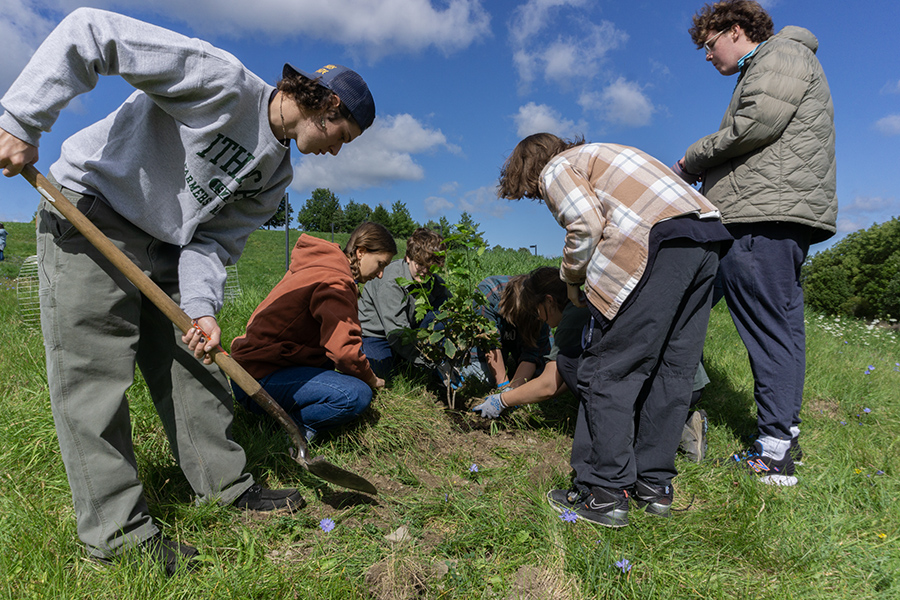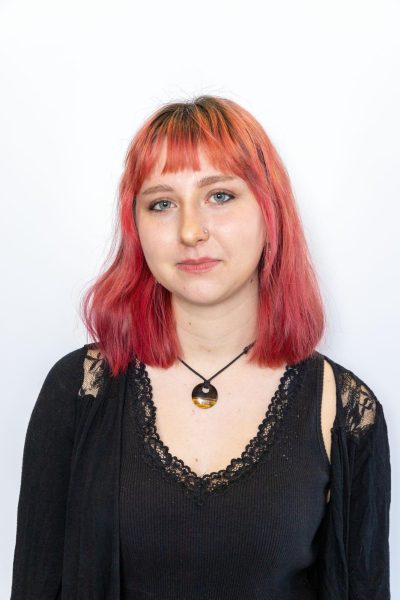On Sept. 8, Ithaca College staff and students collaborated with Trees Up Tompkins to plant native trees on campus behind Emerson Hall. Trees Up Tompkins is a community group devoted to the renewal of Ithaca’s native trees to help draw carbon down from the atmosphere and improve the environment.
John Scott, associate professor in the Department of Media Arts, Sciences, and Studies and Documentary Studies program director, was one of the founding members of Trees Up Tompkins and said they started off as a group of only five or six people.
At the event, Scott said that there were more people present than they had expected when he looked out at the crowd of about 60 students around him.
The group began its efforts with native tree planting on a 1250 square foot area at Lighthouse Point that was full of an invasive privet, which is a type of shrub not native to the United States. After de-weeding the area, they planted over 50 native trees and shrubs in the fall of 2020 and over 60 plants the following year.
“We’ve literally had hundreds of volunteers that have contributed to this,” Scott said. “A lot of our core members are retired… so it’s helpful to have a lot of different people of different ages come.”
But that was not where their work ended.
Trees Up Tompkins began collaborating with Stephen Henhawk, a member of the Indigenous Gayogo̱hó:nǫʼ Nation and research associate of the American Indian and Indigenous Studies Program at Cornell University. Through this relationship, Trees Up Tompkins has been able to contribute to the education of the ancestral and cultural connections that the Gayogo̱hó:nǫʼ people have to this land and these trees.
Mara Alper, professor emerita in the Department of Media Arts, Sciences, and Studies at Ithaca College, was also one of the founding members of Trees Up Tompkins. She first got in contact with Henhawk by going to his Gayogo̱hó:nǫʼ language classes at Cornell.
“I just started showing up at them and waiting for him afterward,” Alper said. “It took about a year and a half for him to understand we were coming from the right place and that it was sincere and genuine.”
Henhawk agreed to translate the names of some of the trees to the Gayogo̱hó:nǫʼ language and provide background on their meanings. Henhawk said there were only 20 first language Gayogo̱hó:nǫʼ speakers left in the world; the translation of the tree names is one way to help keep their language alive.
Henhawk spoke specifically about the bladdernut tree, one of the three native trees chosen to be planted at the college on Sept. 8. The bladdernut tree is the species that he introduced to Trees Up Tompkins when he first heard about the organization.
“The bladdernut [is] what we use … for instruments,” Henhawk said. “The bladdernut has these seeds inside of it and they are very few and far in Ontario and you’re lucky to get a few little seeds out of a pod. So you have to collect a lot of them.”
Along with bladdernut, students and faculty planted red oak, sugar maple and one tulip tree.
Geri Tierney, a member of Trees Up Tompkins, was introduced on Sunday to give the crucial tree planting demonstration.
Planting the trees correctly and with care is one way to give back to the environment. Henhawk spoke about the importance of considering the relationship between people and the land as a reciprocal partnership.
“Because [the Gayogo̱hó:nǫʼ people] lived so closely with nature — the animals, the trees, the environment — we feel we are actually a piece of these ecosystems,” Henhawk said. “It’s a reciprocal relationship where we acknowledge that we need the forest, we need it for heat … it provides us with so many different things, it builds our homes… but in turn, what we need to do and what we do as Gayogo̱hó:nǫʼʼ people is we acknowledge those facts throughout the year at the ripening of the sap, when the sap runs again … when it’s time to collect firewood.”
Henhawk talked about some of the ways the Gayogo̱hó:nǫʼ interact with nature to take care of it.
“In areas of the forest we would do a burn, where we got rid of all the unwanted things in there, so only the mature trees could grow and they could flourish,” Henhawk said. “That’s just one example of this reciprocal relationship that we had with the forest.”
Kimberly Martin, a student of the college who planted one of the trees, talked about why she signed up for this event.
“[I signed up] to do service and to give back, especially since I came from a low-income household,” Martin said. “It feels good to give back to a community.”
As Ithaca College student representatives, juniors Yasmin Ramos Kuczynski and Kennedy Laylon, Documentary Studies and Production majors, marketed the event, making posters and sign up sheets around campus.
Kuczynski said that giving back was a huge part of their involvement in the event.
“Me and Kennedy were asked by John Scott to be student representatives,” Kuczynski said. “It’s good knowing that you were a part of something that was making a change.”
When collaborating with Henhawk to decide how to best incorporate the Gayogo̱hó:nǫʼ connection to the native trees, Scott said Henhawk wanted it to be more than just the translated names.
“He encouraged us to think more broadly about the project as sort of this way to tell the story of … how the Gayogo̱hó:nǫʼ interacted with the trees and continue to interact with the trees,” Scott said. “It’s important to not just put this in past tense because often times with the Gayogo̱hó:nǫʼ, it seems that we’re talking about a history, but it’s also in the present. … These traditions still exist.”
The Gayogo̱hó:nǫʼ have lived on the land that is now called Tompkins County for over 10,000 years. During the American Revolutionary War in 1779, the Gayogo̱hó:nǫʼ people were pushed out because of the “Scorched Earth” campaign. This violence caused many native people to flee to other areas, but their ancestral home is still in Ithaca.
Henhawk said that growing up a Gayogo̱hó:nǫʼ kid, his people were not famous for being driven out; there was much more that was important to who they are.
“I take these opportunities to share our culture of Gayogo̱hó:nǫʼ people,” Henhawk said. “We still have these relationships, even though we’ve been removed for 250 years; they’ve remained alive — our connection to the forest, the lands, to the waters, to the rocks, to everything here. It’s been maintained through song, through our oral histories [and] the great events that have happened here.”
Henhawk also said the work that Trees Up Tompkins is doing with education and awareness is a good first step.
Scott gave advice on how to become part of the solution by being more conscious of the environment. He said to look at the Gayogo̱hó:nǫʼpeople as role models because they have been in Ithaca much longer.
“Plant trees!” Scott said. “Plant trees, get involved, start your own group. Read books about trees and hopefully, we’ll have more ways to interact with some of the really good environmental stewards that were here before us.”















